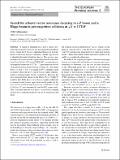Search for a heavy vector resonance decaying to a $${\mathrm{Z}}_{\mathrm{}}^{\mathrm{}}$$ Z boson and a Higgs boson in proton-proton collisions at $$\sqrt{s} = 13\,\text {Te}\text {V} $$ s = 13 Te
Author(s)
Sirunyan, A. M.; Tumasyan, A.; Adam, W.; Bergauer, T.; Dragicevic, M.; Erö, J.; Valle, A. E. D.; Frühwirth, R.; Jeitler, M.; Krammer, N.; Lechner, L.; Liko, D.; Mikulec, I.; Pitters, F. M.; Rad, N.; Schieck, J.; Schöfbeck, R.; Spanring, M.; Templ, S.; Waltenberger, W.; ... Show more Show less
Download10052_2021_Article_9348.pdf (3.726Mb)
Publisher with Creative Commons License
Publisher with Creative Commons License
Creative Commons Attribution
Terms of use
Metadata
Show full item recordAbstract
Abstract
A search is presented for a heavy vector resonance decaying into a
$${\mathrm{Z}}_{\mathrm{}}^{\mathrm{}}$$
Z
boson and the standard model Higgs boson, where the
$${\mathrm{Z}}_{\mathrm{}}^{\mathrm{}}$$
Z
boson is identified through its leptonic decays to electrons, muons, or neutrinos, and the Higgs boson is identified through its hadronic decays. The search is performed in a Lorentz-boosted regime and is based on data collected from 2016 to 2018 at the CERN LHC, corresponding to an integrated luminosity of 137
$$\,\text {fb}^{-1}$$
fb
-
1
. Upper limits are derived on the production of a narrow heavy resonance
$${\mathrm{{{\mathrm{Z}}_{\mathrm{}}^{\mathrm{}}}}}_{\mathrm{}}^{\mathrm{\prime }}$$
Z
′
, and a mass below 3.5 and 3.7
$$\,\text {Te}\text {V}$$
Te
is excluded at 95% confidence level in models where the heavy vector boson couples predominantly to fermions and to bosons, respectively. These are the most stringent limits placed on the Heavy Vector Triplet
$${\mathrm{{{\mathrm{Z}}_{\mathrm{}}^{\mathrm{}}}}}_{\mathrm{}}^{\mathrm{\prime }}$$
Z
′
model to date. If the heavy vector boson couples exclusively to standard model bosons, upper limits on the product of the cross section and branching fraction are set between 23 and 0.3
$$\,\text {fb}$$
fb
for a
$${\mathrm{{{\mathrm{Z}}_{\mathrm{}}^{\mathrm{}}}}}_{\mathrm{}}^{\mathrm{\prime }}$$
Z
′
mass between 0.8 and 4.6
$$\,\text {Te}\text {V}$$
Te
, respectively. This is the first limit set on a heavy vector boson coupling exclusively to standard model bosons in its production and decay.
Date issued
2021-08-03Department
Massachusetts Institute of Technology. Department of PhysicsPublisher
Springer Berlin Heidelberg
Citation
The European Physical Journal C. 2021 Aug 03;81(8):688
Version: Final published version